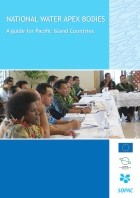National Water Apex Bodies A guide for Pacific Island Countries
 This is a brief introduction to some of the key issues and steps to be considered in the establishment and strengthening of National Water Apex Bodies (NWABs) in Pacific Island Countries. It endeavours to give the reader some initial advice on questions such as:
This is a brief introduction to some of the key issues and steps to be considered in the establishment and strengthening of National Water Apex Bodies (NWABs) in Pacific Island Countries. It endeavours to give the reader some initial advice on questions such as: - What is the point of establishing an NWAB in the first place?
- Who should be involved in the NWAB and how do you involve them?
- How do you run the day-to-day work of the NWAB in order to achieve national goals and to ensure impact on the ground?
More specifically, the guide aims to help national civil servants involved in strengthening NWABs to draft or revise Terms of Reference for their National Water Apex Bodies in order to support reform towards integrated water resources management. For this purpose, the guide includes a checklist for Terms of Reference as Annex 1.
The guide has been put together by SOPAC with funding from the European Union as part of the Pacific IWRM Programme, and is based on issues emerging from the process of developing national diagnostic analyses on IWRM, and from the IWRM Planning Meeting held in Niue in July 2008.
This is a first edition and should not be seen as a complete review but rather a brief introduction to the basics. Feedback on the content and the usefulness of this guide, and suggestions for how to improve it, are gratefully received by iwrm@sopac.org
The guide has been put together by SOPAC with funding from the European Union as part of the Pacific IWRM Programme, and is based on issues emerging from the process of developing national diagnostic analyses on IWRM, and from the IWRM Planning Meeting held in Niue in July 2008.
This is a first edition and should not be seen as a complete review but rather a brief introduction to the basics. Feedback on the content and the usefulness of this guide, and suggestions for how to improve it, are gratefully received by iwrm@sopac.org

















